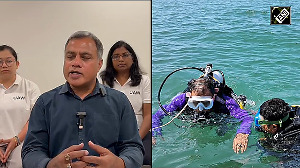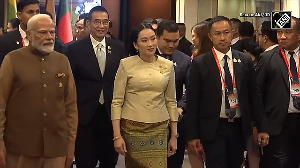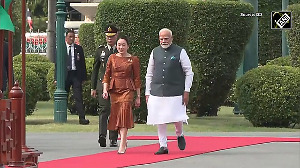That vision stems from the University of Delaware researcher's development of the 'nanobomb' that, he says, can literally blow up breast cancer tumors.
Panchapakesan, assistant professor of electrical and computer engineering at University of Delaware, said he believes that the nanobomb holds great promise as a therapeutic agent for killing cancer cells, with particular emphasis on breast cancer cells.
This is because its shockwave kills not only the cancerous cells, but also the biological pathways that carry instructions to generate additional cells and the small veins that nourish the diseased cells.
Panchapakesan's discovery was recently reported in the journals NanoBiotechnology and Oncology Issues.
"We have a pretty good chance of being successful, as this is a simple technique which is easier to work with and we have demonstrated the technology for in vitro applications or outside the body," Panchapakesan told rediff India Abroad. "Now it's a matter of time to apply it inside the human body to target cancer cells."
He said however that the research is in its early stages, and would require extensive testing and years of clinical trials before the nanobombs could actually be used in medical applications to treat human beings. While these initial experiments are on breast cancer cells, he is also working to extend his method to prostrate cancer and pancreatic cancer.
The researcher, who studied engineering at Regional Engineering College, Rourkela, Orissa, and earned his PhD from the University of Maryland at College Park, said that originally, the research team he heads was looking at the use of carbon nanotubes as drug delivery vehicles.
However, during the experiments, the team made a startling discovery. "We were experimenting with the molecules and considering optical and thermal properties, and found that we could trigger microscopic explosions of nanotubes in a wide variety of conditions," he said.
Panchapakesan explained that nanobombs are incredibly tiny bombs that work like cluster bombs -- once exposed to light and the resulting heat, they start exploding one after the other.
The researchers realised it might be possible to use the microscopic bombs to kill cancer cells. They
"Current cancer treatments are invasive, and often produce a lot of pain, stress and decline in quality of life for patients," Panchapakesan said, explaining why the nanobomb treatment could, on being clinically tested, prove to be the better alternative to conventional treatment.
"By targeting the cancer cells alone, and making tiny bombs that only kill the cancer cells, one can manage pain and quality of life, and also better the chance of curing cancer," he said.
He said nanobombs are superior to a variety of current treatments, including chemotherapy which is selective, because the nanobombs are powerful, selective, non-invasive, non-toxic and can incorporate current technology, including microsurgery.
Asked about gene therapy for cancer, he said gene therapy basically delivers the genes or DNA to the cells which will, or will not, kill the cancer cells. "It's like delivering the genes and hoping the cancer cells would die. However, different people respond to gene therapies differently, and gene therapy has got mixed results and some people have even died because of complications in gene therapy for different diseases," he said.
"Compared to this, what we have done is to be able to identify where these cancer cells are and shoot at them directly, which will also kill all the pathways by which cancer cells communicate."
Nanotechnology, he holds, can also provide new tools for cancer diagnosis through the use of tiny nanosensors. From this, stems his futuristic vision of self-testing at home, and instantaneous cures from a clinic.
Asked if the vision was realistic, he said there was no reason to doubt its potential. "If someone told you in 15th century that we would have blood pressure monitors, vaccines, cure for malaria, computer etc, people might have thought it was all the stuff of science fiction," he pointed out.
"As the understanding of science is accelerating, new things become possible and one day, may be we will have a cure for cancer or just a small procedure to get rid of cancer."
Panchapakesan said the team's findings are the result of interdisciplinary research, in which different sciences came together to work, among them cancer biology, physics, electrical and computer engineering and chemistry. Funding for the research was provided in part by the United States Department of Defense's Congressionally-directed medical research programme.






 © 2025
© 2025